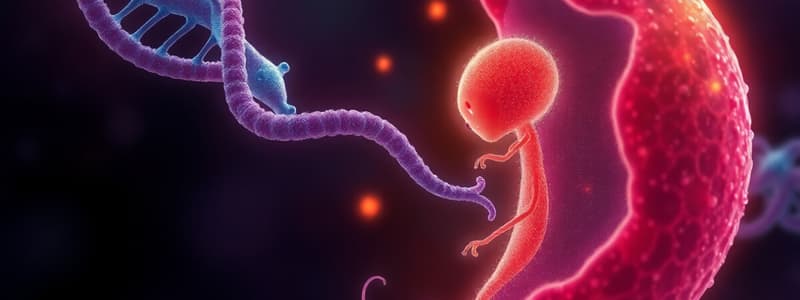Podcast
Questions and Answers
What was the significant conceptual dilemma presented by genomic equivalence?
What was the significant conceptual dilemma presented by genomic equivalence?
- If all cells contain the same genes, why are certain proteins produced only in specific cell types? (correct)
- The realization that chromosomes are derived from the mitotic descendants of chromosomes from fertilization.
- The observation that all cells in an organism have the same number of chromosomes.
- The understanding that bacterial gene regulation is fundamentally different from eukaryotic gene regulation.
Which regulatory mechanism directly affects the quantity of nuclear RNA available for translation?
Which regulatory mechanism directly affects the quantity of nuclear RNA available for translation?
- Selective messenger RNA translation.
- Differential gene transcription.
- Selective nuclear RNA processing. (correct)
- Differential protein modification.
According to the central dogma, what information is copied during transcription?
According to the central dogma, what information is copied during transcription?
- Messenger RNA (mRNA) into a protein.
- Nuclear ribonucleic acid (nRNA) into messenger RNA (mRNA).
- Amino acid sequence into a polypeptide chain.
- DNA base sequence into nuclear ribonucleic acid (nRNA). (correct)
In the context of differential gene expression, what is the significance of polytene chromosomes?
In the context of differential gene expression, what is the significance of polytene chromosomes?
In the context of somatic cell nuclear transfer, what is the most accurate description of the role of the oocyte?
In the context of somatic cell nuclear transfer, what is the most accurate description of the role of the oocyte?
What is the direct effect of histone acetylation on gene expression, and how is it achieved?
What is the direct effect of histone acetylation on gene expression, and how is it achieved?
How does histone methylation differ from histone acetylation in regulating gene expression?
How does histone methylation differ from histone acetylation in regulating gene expression?
What is the role of Trithorax and Polycomb group proteins in maintaining a 'memory' of gene expression?
What is the role of Trithorax and Polycomb group proteins in maintaining a 'memory' of gene expression?
What best describes the arrangement of exons and introns on eukaryotic mRNA?
What best describes the arrangement of exons and introns on eukaryotic mRNA?
What is the role of the 5' cap and the poly(A) tail in eukaryotic mRNA?
What is the role of the 5' cap and the poly(A) tail in eukaryotic mRNA?
In gene regulation, what is the primary function of basal transcription factors?
In gene regulation, what is the primary function of basal transcription factors?
In eukaryotic gene regulation, what is the role of enhancers and silencers?
In eukaryotic gene regulation, what is the role of enhancers and silencers?
How do transcription factors bound to enhancers affect gene transcription at the promoter?
How do transcription factors bound to enhancers affect gene transcription at the promoter?
What role does the Mediator complex play in eukaryotic gene transcription?
What role does the Mediator complex play in eukaryotic gene transcription?
What role do pioneer transcription factors play in regulating gene expression?
What role do pioneer transcription factors play in regulating gene expression?
How can the Pax6 protein function as a master regulator in eye and pancreas development?
How can the Pax6 protein function as a master regulator in eye and pancreas development?
What is the function of the neural restrictive silencer element (NRSE)?
What is the function of the neural restrictive silencer element (NRSE)?
How can a single gene give rise to different proteins through alternative nRNA splicing?
How can a single gene give rise to different proteins through alternative nRNA splicing?
What is the function of differential mRNA processing?
What is the function of differential mRNA processing?
In the context of mRNA processing, what is the role of spliceosomes?
In the context of mRNA processing, what is the role of spliceosomes?
In mammals, what is the significance of genomic imprinting with regard to gene expression?
In mammals, what is the significance of genomic imprinting with regard to gene expression?
What role does DNA methylation play in genomic imprinting?
What role does DNA methylation play in genomic imprinting?
During the development of red blood cells, what is the relationship between globin gene promoters and their methylation status?
During the development of red blood cells, what is the relationship between globin gene promoters and their methylation status?
How does the RNA-induced silencing complex (RISC) regulate gene expression?
How does the RNA-induced silencing complex (RISC) regulate gene expression?
How does the eukaryotic translation of a gene get going and proceed?
How does the eukaryotic translation of a gene get going and proceed?
During what steps of differential gene expression do the Hu proteins operate, and on which cell types are they found?
During what steps of differential gene expression do the Hu proteins operate, and on which cell types are they found?
How does a mutation of Rpl38 result in defective Hox gene expression and what tissues are affected?
How does a mutation of Rpl38 result in defective Hox gene expression and what tissues are affected?
What steps are used in determining specific nucleotide transcript location?
What steps are used in determining specific nucleotide transcript location?
In CRISPR-Cas9 technique, there are several steps in creating successful cuts and knockouts. Which statements are generally correct in describing the mechanisms and steps involved ? Note: Not all steps are listed (not about delivery etc)
In CRISPR-Cas9 technique, there are several steps in creating successful cuts and knockouts. Which statements are generally correct in describing the mechanisms and steps involved ? Note: Not all steps are listed (not about delivery etc)
Flashcards
What is differential gene expression?
What is differential gene expression?
Cells become different from one another based on the unique combination of genes that are active or expressed.
What is genomic equivalence?
What is genomic equivalence?
The concept that each somatic cell nucleus has the same chromosomes and genes.
What is the result of selective protein production?
What is the result of selective protein production?
Selective production of different proteins within cells, creating diversity.
What mechanisms lead to differential gene expression?
What mechanisms lead to differential gene expression?
Signup and view all the flashcards
What is differential gene transcription?
What is differential gene transcription?
Signup and view all the flashcards
What is selective nuclear RNA processing?
What is selective nuclear RNA processing?
Signup and view all the flashcards
What is selective messenger RNA translation?
What is selective messenger RNA translation?
Signup and view all the flashcards
What is differential protein modification?
What is differential protein modification?
Signup and view all the flashcards
What is the first postulate of differential gene expression?
What is the first postulate of differential gene expression?
Signup and view all the flashcards
What is the second postulate of differential gene expression?
What is the second postulate of differential gene expression?
Signup and view all the flashcards
What is the third postulate of Differential Gene Expression?
What is the third postulate of Differential Gene Expression?
Signup and view all the flashcards
What is the central dogma of biology?
What is the central dogma of biology?
Signup and view all the flashcards
What is transcription?
What is transcription?
Signup and view all the flashcards
What is translation?
What is translation?
Signup and view all the flashcards
What are polytene chromosomes?
What are polytene chromosomes?
Signup and view all the flashcards
What is cell culture?
What is cell culture?
Signup and view all the flashcards
What is phenotype?
What is phenotype?
Signup and view all the flashcards
What is chromatin?
What is chromatin?
Signup and view all the flashcards
What is a nucleosome?
What is a nucleosome?
Signup and view all the flashcards
What is heterochromatin?
What is heterochromatin?
Signup and view all the flashcards
What is euchromatin?
What is euchromatin?
Signup and view all the flashcards
What is histone acetylation?
What is histone acetylation?
Signup and view all the flashcards
What is histone methylation?
What is histone methylation?
Signup and view all the flashcards
What are Trithorax and Polycomb proteins?
What are Trithorax and Polycomb proteins?
Signup and view all the flashcards
What are exons?
What are exons?
Signup and view all the flashcards
What are introns?
What are introns?
Signup and view all the flashcards
What is the promoter region?
What is the promoter region?
Signup and view all the flashcards
What are promoters?
What are promoters?
Signup and view all the flashcards
What are enhancers?
What are enhancers?
Signup and view all the flashcards
What are silencers?
What are silencers?
Signup and view all the flashcards
What are transcription factors?
What are transcription factors?
Signup and view all the flashcards
What is co-ordinated gene expression?
What is co-ordinated gene expression?
Signup and view all the flashcards
What are insulators?
What are insulators?
Signup and view all the flashcards
What are pioneer transcription factors?
What are pioneer transcription factors?
Signup and view all the flashcards
What are 'master regulatory' transcription factors?
What are 'master regulatory' transcription factors?
Signup and view all the flashcards
What occurs in cell dedifferentiation?
What occurs in cell dedifferentiation?
Signup and view all the flashcards
What are Yamanaka factors?
What are Yamanaka factors?
Signup and view all the flashcards
What are splicing isoforms of the protein?
What are splicing isoforms of the protein?
Signup and view all the flashcards
What are transcription factor domains?
What are transcription factor domains?
Signup and view all the flashcards
Study Notes
Differential Gene Expression and Cell Differentiation
- Embryonic development involves a single cell differentiating into many cell types
- Somatic cell nuclei each contain the same chromosomes and genes
- Genomic equivalence stipulates all body cells contain the same genes
Selective Gene Activation
- Differential gene expression makes cells different based on the combination of active genes
- Selective protein production promotes cellular diversity
- Gene expression differences govern maturation toward distinct cell types during zygote division
- Regulatory mechanisms modulating differential gene expression target DNA access, RNA production/processing, protein synthesis/modification include:
- Specific transcription factors binding gene promoters
- Histone modification to alter chromatin accessibility
- RNA degradation and alternative splicing,
- Translational controls
- Post-translational protein modifications
- Protein transport changes
Postulates of Differential Gene Expression
- Somatic cells contain the complete genome from the fertilized egg
- Unused genes are not destroyed or mutated, retaining expression potential
- Only a small genome percentage expresses itself in each cell
- RNA synthesized is unique to the certain cell type
Gene Expression Regulation Levels
- Gene expression has four regulation levels
- Differential gene transcription regulating transcribed nuclear genes into nuclear RNA
- Selective nuclear RNA processing regulating transcribed RNAs that enter the cytoplasm/become messenger RNAs
- Selective messenger RNA translation regulating mRNAs translated into proteins
- Differential protein modification regulating proteins to remain and function in a cell
- Some genes, like globin protein subunits of hemoglobin, regulate at all levels
Genomic Equivalence Evidence
- Polytene chromosomes in Drosophila larvae exhibit no structural differences between cells
- However, chromosome regions "puff up" during RNA production
- Nucleic acid in situ hybridization studies confirmed these findings
- Odd-skipped gene mRNA indicates a segmented pattern in the Drosophila embryo
- The mouse homolog, odd-skipped related 1, uniquely expresses itself in branchial arches, limb buds, and the heart
Cloning and Nuclear Equivalence
- Nuclear transplant experiments demonstrate somatic cell nuclei of origin can direct an organism's entire development
- Dolly the sheep was cloned in 1997 using a mammary gland cell nucleus
- Cells were kept in the G1 phase, then fused with enucleated oocytes using electric pulses, activating development
- DNA analysis verified that Dolly's cells originated from the donor nucleus strain
- Cloning of adult mammals has since occurred in other animals
- Nuclei of vertebrate adult somatic cells contain the required development genes
- Somatic cell nuclei are equivalent
DNA and Chromatin
- Eukaryotic (but not prokaryotic) genes are contained in the DNA and chromatin complex
- Histones form the protein component of chromatin, particularly the nucleosome
- An octamer creates the nucleosome of histone proteins (two molecules each of H2A, H2B, H3, and H4) wrapped with two DNA loops (approx. 147 base pairs)
- Histone H1 binds linker DNA (60-80 base pairs) between the nucleosomes
- DNA has multiple contacts with histones to enable packaging into the nucleus
Nucleosomes
- Solenoids tightly wind the nucleosomes, stabilized by histone H1
- H1-dependent nucleosome conformation inhibits somatic cell gene transcription
- Tightly packed chromatin regions are called heterochromatin
- Loosely packed areas are called euchromatin
- Regulating how tightly packed an area of chromatin is modulates gene accessibility for transcription
Histones as Gene Expression Gatekeepers
- Modifying histone "tails" of H3 and H4 controls repression and activation
- Histone acetylation (adding negatively charged acetyl groups) loosens the histones and activates transcription
- Histone acetyltransferases add acetyl groups, destabilizing nucleosomes and making them euchromatic
- Histone deacetylases remove acetyl groups, stabilizing nucleosomes to prevent transcription (heterochromatic)
Histone Methylation
- Methylation can activate/repress transcription
- Acetylation, along with three methyl groups on lysine at position four of H3 (H3K4me3), usually means active transcription
- Lack of acetylation and methylation on the lysine in the ninth position of H3 (H3K9) means repressed chromatin
Memory of Methylation
- Histone modifications recruit proteins from the Trithorax and Polycomb families, retaining the transcriptional state from generation to generation
- Trithorax proteins keep active genes active
- Polycomb proteins maintain a repressed state through condensed nucleosomes
Polycomb Proteins
- Polycomb proteins repress sequentially
- First set methylates lysines H3K27 and H3K9 to repress a gene
- Second set binds methylated tails of histone 3, keeps methylation active, methylates adjacent nucleosomes, forms tightly packed repressive complexes
Trithorax Proteins
- Act to counter the Polycomb proteins effects
- Modify/alter nucleosome positions, allowing transcription factors to bind DNA
- Trimethylated H3K4 lysine is kept from from demethylating into a dimethylated, repressed state
Anatomy of Eukaryotic genes
- Modulating gene access via histone methylation affects expressions
- Regulated directly through methylation targeting DNA
- Non-colinear with their peptide products
- Eukaryotic mRNA comes from noncontiguous regions on the chromosome
- The single nucleic-acid strand
Exons and Introns
- Exons : DNA regions that encode parts of a protein
- Introns: Intervening sequences with no information for coding
- 5' region: where RNA polymerase II binds
- Transcription initiation site: ACATTTG for human β-globin
- the "cap sequence" where a modified nucleotide "cap" is added soon after transcription
- 5' untranslated region (5' UTR; leader sequence)
- 50 base pairs
- Determines translation rate
- Translation initiation site: ATG becomes AUG in mRNA
- Located 50 base pairs after the transcription initiation site in the human β-globin gene
- Protein-encoding portion of the first exon
- 90 base pairs for amino acids 1–30 of human β-globin protein
- An intron
- 130 base pairs
- Non-coding structure enables RNA processing and exit from nucleus
- Exon containing 222 base pairs
- Amino acids 31-104 coded for
- Large Intron
- 850 basepairs, no coding sequence
- Exon
- 126 base pairs coding for amino acids 105-146
- Translation Termination Codon
- TAA becomes UAA
- signals that the ribosome dissociate and for protein release
- 3' untranslated region (3' UTR)
- Includes polyadenylation sequence AATAAA
- tail of 200-300 adenylate residues; stabilizes mRNA, allows nucleus exit, permits mRNA translation
- Transcription Termination Sequence
- Continues beyond AATAAA site for ~1000 nucleotides before terminating
Nuclear RNA (nRNA)
- The original transcription product, containing the cap sequence, 5’ UTR, exons, introns and the 3’ UTR
- Undergoes ends modification before leaving the nucleus
- A methylated guanosine cap anchors the 5' end of the RNA; for mRNA binding to ribosome/translation
- A polyA tail of adenylate residues to the 3' end for stability/protection from exonucleases
- Introns are removed and exits spliced together
cis-Regulatory elements: the On/Off switches
- Promoters: Site with RNA polymerase II binds, starts transcription
- Most contain CpG islands
- Basal transcription factor proteins: saddle and recruit RNA polymerase II
Enhancers
- Recruit and stabilize RNA polymerase II
- Signals where/when to use a promoter, how much gene product to make
- Controls efficacy/rate of transcription from a specific promoter
- Transcription factors to bind specific promoters/enhancers/silencers
- Recruit enzymes that break up area nucleosomes
Studying That Suits You
Use AI to generate personalized quizzes and flashcards to suit your learning preferences.




